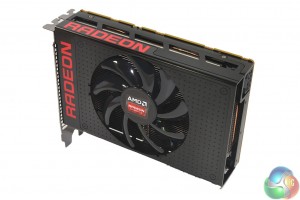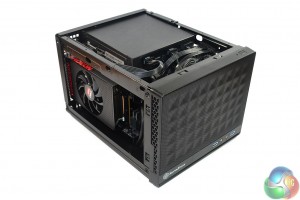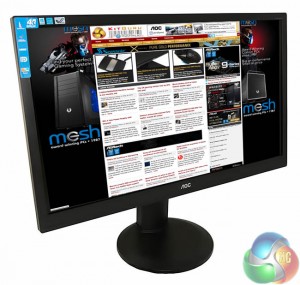For the review today we are using the Catalyst 15.201.1102 driver that was supplied to us by AMD for the R9 Nano launch. Unfortunately due to a very tight schedule with the card, we did not have enough time to re-test every other piece of Nvidia and AMD hardware using the latest drivers. With that said, even the oldest drivers that we used are very recent (AMD Catalyst 15.7.1 and Nvidia 355.60).
Our testing will take place inside a well-cooled NZXT Phantom 630 chassis with its side panels removed. This is the exact same test configuration that we have used for all comparison graphics cards, so it ensures consistency, even if the R9 Nano is unlikely to be used inside such a large full tower chassis. The point of this is to initially show R9 Nano performance without any thermal handicaps induced by a SFF test environment.
We test using the 2560×1440 and 4K resolutions because gamers purchasing a £500+ card are likely to be running monitors with those screen resolutions.
Overclocked performance for the R9 Nano will be included in the 4K tests for two reasons; 1 – 4K demands every last slither of performance that a graphics card can deliver and 2 – we simply did not have enough time to test (and re-test) the overclocked card through our 1440P performance suite.
We will also be taking a look at how the R9 Nano performs inside a high performance SFF gaming build that will be at home under a large TV or next to a high-res monitor. For this test scenario, we will be running a small number of benchmarks at 1920×1080 and 4K, as they are the most popular TV resolutions for users with a gaming HTPC.
The objective here is to see if the card shows significant performance degradation and signs of thermal throttling when the card is crammed inside its most applicable usage environment.
We test using the AOC U2868PQU 4K monitor that scored highly in our review that can be found HERE. AOC's 28″ offering is one of the most affordable 4K monitors on the market and makes the realms of 4K gaming more accessible to a wider audience.
Test System
- Processor: Intel Core i7 5960X ES (4.4GHz OC).
- Memory: 16GB (4x 4GB) Corsair Vengeance LPX 3200MHz DDR4.
- Motherboard: Asus X99-Deluxe.
- System Drive: 500GB Samsung 840.
- CPU Cooler: Corsair H100i.
- Case: NZXT Phantom 630.
- Power Supply: Seasonic Platinum 1000W.
- Operating System: Windows 7 Professional with SP1 64-bit.
Graphics cards (comparisons):
- AMD R9 295X2 (Catalyst 15.7.1)
- AMD R9 Fury X (Catalyst 15.7.1)
- Asus R9 390X STRIX OC (Catalyst 15.201.1102 – R9 Nano launch)
- Sapphire R9 380 ITX Compact (Catalyst 15.201.1102 – R9 Nano launch)
- Nvidia GTX Titan X reference (ForceWare 355.60)
- EVGA GTX 980 Ti Classified ACX 2.0+ (ForceWare 355.60)
- Nvidia GTX 980 Ti reference (ForceWare 355.60)
- Asus GTX 980 STRIX OC (ForceWare 355.82)
- Asus GTX 970 DCU Mini (ForceWare 355.82)
Software:
Unigine Heaven Benchmark
3DMark
Fraps
Steam Client
MSI Afterburner
TechPowerUp GPU-Z
Games:
Battlefield 4
Bioshock Infinite
Grand Theft Auto V
Metro: Last Light
Middle Earth: Shadow of Mordor
Tomb Raider
Game descriptions edited with courtesy from Wikipedia.
 KitGuru KitGuru.net – Tech News | Hardware News | Hardware Reviews | IOS | Mobile | Gaming | Graphics Cards
KitGuru KitGuru.net – Tech News | Hardware News | Hardware Reviews | IOS | Mobile | Gaming | Graphics Cards






Price!! AMD… I know it’s unique but you had a good opportunity to fight NVIDIA but you priced yourself too high (again).
And with their yield issues it will be priced even higher at retailers lol.
Who are you kidding?
I can’t see how they can charge the same as a Fury X and the Fury X has the added cost of watercooling.
Don’t matter on price, Gaming enthusiast’s will buy it just because of the size and performance it give’s, If people are willing to spend like 1500 for a titan X, I’m sure people will pay 1/3 of the price for the nano.
Can you cram Fury x into SFF case?
^ This, it delivers very well for the size/form factor in spades. But if anyone has the space/non ITX case to house longer cards the Nano isn’t for them, people just need to realize this and move on.
yes. Read a review somewhere (Hexus?) where they mentioned you could cram a Fury X into some mITX cases 🙂
Most mITX cases are long, to incorporate a full sized GFX card, you can for example get a Strix 980 into a Fractal Node 304. It’s only when you get down to stuff like the Coolermaster Elite 110 that an mITX card becomes necessary.
For £515 you can buy a 980Ti, unless you really needed a smaller card why would you purchase this ?
Indeed. Most of the people complaining about the niche this card lives in wouldn’t be buying one anyway, they’re just more interested in complaining about it.
Most of the complaining is from nvidia fanboys, trolls or paid shills. There is no way a sane consumer can be totally blind to the value proposition this card gives in ultra SFF compared to useless value the titan X gives when it is so overpriced for any form factor.
Of course there are some legitimate voices of dissatisfaction among those who really wanted to buy this card thinking it will be a more cut down version of Fiji chip and could be had for like 400-450 USD, those people have legit reasons to be slightly miffed but given the performance this thing shows they will quickly realize this card isn’t for them, the $549 R9 Fury is.
I would buy it with no hessitation, and I’m a full tower user.